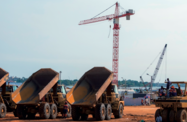
– Sustainable architecture is increasingly seen as a tool to lower construction emissions
– Projects incorporating traditional designs and local materials have proven successful
– The upcoming 2022 FIFA World Cup in Qatar aims to be a carbon-neutral event
– Regenerative architecture is seen as key to creating climate-positive buildings

Amid efforts to reduce the carbon footprint associated with the construction industry, there is increasing recognition of the benefits of sustainable and regenerative architecture as a means of lowering emissions.
The construction sector is one of the world’s biggest polluters. According to the “2019 Global Status Report for Buildings and Construction” published by the UN Environment Programme (UNEP), the sector accounts for close to 40% of global energy-related greenhouse gas emissions.
In light of this, a greater emphasis has been placed on sustainable architecture in recent years.
Although definitions vary somewhat, sustainable architecture is generally considered to be architecture that seeks to minimise the negative environmental impact of buildings. This is often achieved through the use of environmentally sustainable, low-emission materials, as well as site-specific designs that utilise the natural environment to improve efficiency and lower costs related to areas such as lighting and heating.
While much progress has been made on sustainable architecture in recent years, there is still significant potential for improvement.
According to modelling from the UNEP’s International Resource Panel, emissions from the material cycle of residential buildings in the G7 and China could be reduced by at least 80% by 2050.
This could be achieved through a series of material efficiency strategies, such as building with fewer or alternative components, or recycling more construction materials.
Sustainable architecture in emerging markets
Some emerging markets are taking the lead when it comes to sustainable architecture, often by incorporating traditional designs and materials into construction.
For example, in March Diébédo Francis Kéré, an architect from Burkina Faso, became the first African to be awarded the Pritzker Prize, widely considered to be the world’s most prestigious architecture prize, for his work designing sustainable buildings in Africa.
Through revising and modernising traditional building techniques, Kéré’s buildings are integrated into the natural environment in order to improve their effectiveness in terms of light, heating and cooling – and are therefore more energy efficient.
His first major project – a single-storey schoolhouse in his home village of Gando in Burkina Faso – features a filtered light system that allowed natural light into the building while keeping the interior cool.
He has since designed schools, health centres, assembly halls and other public buildings in Benin, Mali, Togo, Kenya, Mozambique and Sudan. Kéré works in close partnership with local builders who use indigenous, low-tech construction methods and locally available materials.
Meanwhile, as OBG has reported, in Egypt local design and building company Hand Over has in recent years been a forerunner in sustainable construction.
Using a technique known as “rammed earth construction”, which deploys eco-friendly materials such as gravel, mud and sand, plus a small amount of cement, the company has constructed a number of sustainable housing and building projects across the country.
The technique has been shown to reduce heat and dampness in a building, leading to an estimated 30% reduction in carbon emissions on the back of lower energy usage.
Elsewhere, in an example of large-scale sustainable infrastructure development, Qatar is planning to host the 2022 FIFA World Cup in November and December as a carbon-neutral event, meaning that all infrastructure, including tournament stadia, will meet sustainability benchmarks.
Innovations include using recycled materials during construction and implementing a series of water- and energy-savings solutions.
The country has also constructed the first fully demountable stadium in World Cup history: Stadium 974 in Ras Abu Aboud is made from modular shipping containers and will be repurposed into a range of sporting facilities after the tournament.
In total, Qatar says that the tournament’s stadia will be 30% more efficient than international benchmarks through the use of energy-efficient features such as thick insulation, efficient cooling and ventilation, LED lighting and building control systems.
Organisers are also expected to use 40% less water than international benchmarks. For example, water vapour collected from the cooling system will be used for irrigation, while water-efficient fixtures have been implemented in sinks, showers and toilets.
Regenerative architecture
In recent times there has also been discussion around the benefits of regenerative architecture.
Regenerative architecture refers to the design of buildings that reverse damage and have a net-positive impact on the environment.
On example is the Ilima Primary School in Tshuapa in the Democratic Republic of the Congo. Located between farmland and jungle, the school was designed to act as a bridge between the two landscapes.
Comprising custom shingles, mud bricks and beams made from local materials, the school also features woven and dyed vines that grow around the building to keep the interior cool.
The school’s construction emitted 307 fewer tonnes of carbon than the global average for schools of the same size.
The Sahara Forest Project Pilot Facility in Qatar is another example of regenerative architecture. Since construction started in 2012, the saltwater-cooled greenhouse has attracted a number of birds, grasshoppers, butterflies and rodents in an area that was once barren desert.



